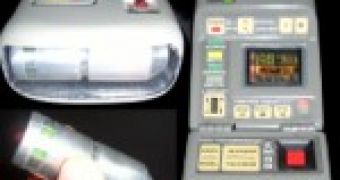September 11, 2001 - New York, USA; July 7, 2005 - London, UK; September 2, 2004 - Moscow, Russia; March 11, 2004 - Madrid, and the list could go on...
The terrorist attacks have made the whole world see the real threat of international terrorism in a different light. Researchers from many countries have concentrated their efforts on the development of methods and special equipment with which it will be possible to detect explosive objects in advance. Such devices include various sensor and detection systems playing a leading role.
Today, all modern airports implement luggage control that is usually performed with stationary X-ray devices with 2D project imaging of objects, which do not provide a full picture about material information or in-depth resolution. For comparison, the control of people at the same airports is performed with metal stationary (with sound signals) or hand-operated detectors.
In a number of cases physical body control of a person is performed but it is considered unpleasant from both controllers' and passengers' point of view.
Unfortunately, with the exception of physical controls, all the other methods do not provide a comprehensive body of data on dangerous non-metal objects, plastic and liquid explosive materials and substances etc.
Help is on the way, as Georgian scientists (a former soviet republic, familiar with terrorist attacks and separatist movements) are actively involved in the development of a new multisensor detection system for three-dimensional (3D) imaging and signal processing that will help to receive information not only in the form and size of an object but also on the material that this object is made of.
It may sound like the "Tricorder", a compact and complex hand-held scanning device featured in the sci-fi Star Trek world, but it may also become more "sci-" and less "fi-".
"One of today's existing developments, created in the field of microwave detection," explains Nina Pavlovna Khuchua, Head of Laboratory at Tbilisi State University, "is a system developed in the USA and designed for three-dimensional imaging of hidden weapons, detected with the help of a signal on milimeter waves. However, this system has a number of major shortcomings. The most essential among them is that it is stationary, in other words, this system cannot be moved from place to place. Moreover, an operator determines, without additional checking, whether the discovered object is an explosive or not."
At the heart of the developed multisensor system lies a combination of two methods that use various physical principals: microwave sensing and X-ray scanning. This combination will give additional information (in addition to size and form of hidden objects, the characteristics of material and distance from sensor to object), including enhanced spatial resolution.
The scientists assume the implementation of a new approach to microwave sensing with the application of a quadrature sensor concept that will help to determine object parameters more precisely and exclude all key "parasitic" effects that impair measurement accuracy. Multiple X-ray line detectors with different energy thresholds will be used for X-ray scanning. The application of 3D inversion algorithms and algorithms of data synthesis facilitate the receipt of three-dimensional images of an object from both of these detectors. The detectors will be made on the basis of a semiconductor GaAs and related compounds.
Need to count the applications?
Identifying dangerous metal and non-metal objects and materials in both baggage and attached on individual passengers, as a result of which the researchers will be able to avoid physical body control.
It could also determine dangerous liquid materials in concealed cavities, such as footwear, due to its portability, and eliminate health hazards posed by X-ray radiation sensors, since the duration of the monitoring will be no more than 1-2 seconds.

 14 DAY TRIAL //
14 DAY TRIAL //